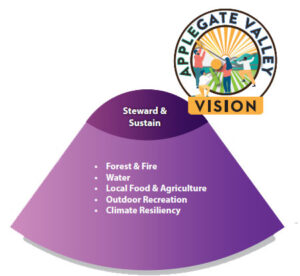 The Applegate Valley’s economy has been through many phases—mining, logging, wine, hemp and increasingly become a recreation and tourism-related economy. It’s difficult, though, to obtain exact measurements of these “economic generators.”
The Applegate Valley’s economy has been through many phases—mining, logging, wine, hemp and increasingly become a recreation and tourism-related economy. It’s difficult, though, to obtain exact measurements of these “economic generators.”
How much benefit do these different activities contribute and how do they compare with one another? What are the environmental, aesthetic and social impacts of each industry?
Since the Applegate Valley is spread between three counties—Jackson, Josephine and Siskiyou—it’s difficult to get a clear picture. The available data sets are fragmented. How do we then make clear decisions on how to invest and cultivate our Applegate Valley resources?
Audrey Eldridge and Liza Crosse from the Wellington Wildlands Council hope to gain a more accurate picture of the local economy. They applied for and were awarded an Innovation Grant from A Greater Applegate to help fund a study of our current economic drivers. This project falls under the Prosperous & Vital section of the Applegate Valley Vision. The Vision is an 89-page, resident-guided document that details hopes and aspirations for the future of the valley.
Liza and Audrey’s interest in the topic was sparked by the imperiled Wellington Wildlands area. The 7,500 acres forest parcel is located up Forest Creek Road on the slopes of Mt. Isabel and constitutes the last remaining roadless areas between Grants Pass and Medford. There you can experience the old-growth forest and biodiversity that make the Applegate Valley special.
The Wellington area could be eligible for permanent federal protection as a Wilderness Area so long as it stays an intact 7,500 acres. However, a proposed timber sale (called “Bear Grub”) would reduce the wilderness characteristics of the area and therefore make it ineligible for this protection.
 One of the goals of the economic study would be to answer the question: Are these wildlands more valuable as a recreational and environment resource, or more valuable for logging? Ideally the study would not only assess market values, but also non-market values such as clean water, aesthetics and fresh waters.
One of the goals of the economic study would be to answer the question: Are these wildlands more valuable as a recreational and environment resource, or more valuable for logging? Ideally the study would not only assess market values, but also non-market values such as clean water, aesthetics and fresh waters.
“Some of the values don’t necessarily have real dollar amount that you can attach to them, but they are all issues that need to be weighed in on,” says Liza.
When it comes to forest management, Audrey acknowledges that there are complicating issues. For example, recent drought-related wildfires call for some fuel reductions work. “We are not all anti-logging,” she says. “We certainly support forest management and, in the right places, thinning.”
But on the protection of the Wellington Wildlands area, Liza and Audrey are unequivocal.
“There is absolutely no doubt that we need to protect these most important places, biologically speaking,” Audrey explains. “Old trees warrant protection because of the biodiversity they support and carbon they sequester.”
Logging moist forest canyons causes them to dry out and become less drought- resistant and more vulnerable to beetle damage.
“They just can’t sustain the added dryness that comes with the combination of climate change and logging,” she says.
Some of the current logging practices are designed to meet old federal mandates for the BLM to log a certain number of board feet. Audrey and Liza hope that by studying all the values that areas like the Wellington Wildlands bring to the community, informed forest practice decisions can be made.

